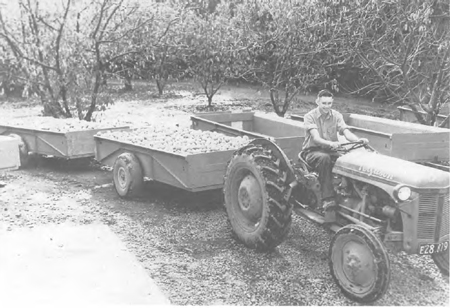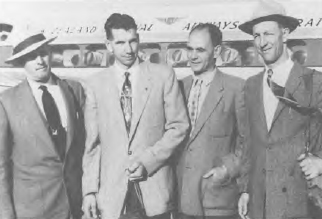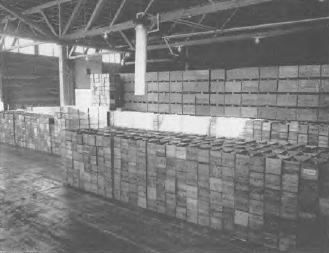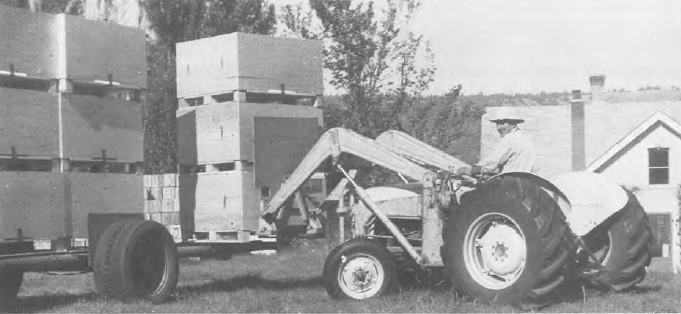News & Events More |
The MacPhee Report
Dean MacPhee, having once started his investigation, interpreted his instructions in the most comprehensive possible way. His research, by the time it was completed, included thirty-three public hearings with submissions by 259 witnesses; fifty-five private hearings and meetings with various boards, committees, and delegations; and travel as far afield as the Prairies, Eastern Canada, and Washington to investigate markets and production conditions. MacPhee's eventual Report of the Royal Commission on the Tree-Fruit Industry of British Columbia was delivered to the government in October, 1958, but was not released to the public until early in 1959, more than two years after MacPhee began his investigation. Vignette: The Apple BinIn 1954 Dr. James Marshall, head of the entomological laboratory at the Summerland Research Station, was invited to visit New Zealand to explain to fruit growers there the new method of concentrate spraying which had been developed in the Okanagan. While there, he picked up an idea which the New Zealanders, chronically short of orchard labour, had come up with to ease operations: the bulk orchard apple bin. A grower on the South Island had devised shallow, linoleum-lined, 100 bushel bins mounted on war-surplus bomber tires, which could be towed full to the packing house. Thus, much of the labour involved in individually handling single bushel boxes, as many as seven times between picker and packer, was removed.  Dr. Marshall, impressed by the increased speed of harvest, ease of handling, and reduced fruit bruising with the bulk handling system, began a one-man campaign for its introduction in the Okanagan. After discussion at the 1957 B.C.F.G.A. convention, a delegation was sent to New Zealand, consisting of Stan Porritt from the Summerland Experimental Station, Frank Morton of Kelowna for the Provincial Department of Agriculture, Don Sutherland of Kaleden and Vern Ellison of Oyama as representatives of the growers, and J.B. Lander, Sales Manager of B.C. Tree Fruits Ltd. On their return and favourable report, an industry committee speedily agreed on dimensions for a bin to be used by all Okanagan packing houses: 48 inches by 43 inches by 24 inches deep, holding 25 loose boxes of apples. These measurements are still the standard in use. This bin is easily handled with forks on a tractor's three-point hitch, fits compactly on a standard flat-deck truck, and allows maximum use of space in a cold-storage room. The only significant change from the initial design is the deletion of a hinged gate originally put at the end of the bin to allow dumping of the contents onto the packinghouse grader line. Apples are now "dumped" by floating the fruit out of the bin, so the end gate is no longer necessary.  These uniform plywood bins were manufactured by S.M. Simpson Ltd. of Kelowna. Initially the mill made only the basic parts, and bins were assembled by packinghouse staff during the off-season, but after 1963 whole bins were produced at the S.M. Simpson bin plant in Kelowna. At first, the bins for each house were dipped in a different colour of preservative to distinguish them, but this involved too much inconvenience in having to drain and clean the dip tank for each order, so now only one colour of preservative is used and each bin is stencilled with the name of the packing house and the year of manufacture. This plant, now part of Crown Forest Industries Ltd., supplies bins in large quantities not only to the Okanagan but also to American packinghouses; the millionth bin was made for Lake Chelan Fruit Growers Inc. in Chelan, Washington, about 1970. The total manufactured is now over two million, with shipments as far afield as England and Costa Rica. The long-awaited report consisted of no fewer than 816 printed pages. It described and analysed the history of the fruit industry and of control legislation, production methods and costs, packing and marketing procedures, and the various organizations which handled and sold fruit. He finished with predictions on the future of the industry. Never before, and never since, has such a thorough and all-embracing study been completed, so that even today, thirty years after the MacPhee Report appeared, it is still frequently consulted and used as a reference. The Report has often and justly been described as the "Bible" of the industry. MacPhee's investigation had been viewed with some apprehension by the growers' organization: As is probably well known, the Commissioner is, personally, a believer in private enterprise, with a minimum of compulsory control, and has required clear evidence that the existing and generally accepted philosophy was the correct one for this industry. But the Commissioner did not force preconceived conclusions upon his investigations. Instead, after his extremely deep inquiries, he finished by giving general approval to the system as it stood. He recommended no changes to the structure of the B.C.F.G.A., and said that complaints about undemocratic election proceedings were unfounded. The tendency for members to remain on the executives of the various governing boards year after year arose not from the operation of some "family pact", but from the difficulty of getting good men to stand for election and from the general satisfaction of most growers with their performance. "The domination of the industry by the executive of the British Columbia Fruit Growers' Association, and particularly by Mr. Garrish, is not something that can be amended by legislation, and the fact remains that Mr. Garrish has been re-elected for the eighth time as president of the organization."
On the marketing side, MacPhee similarly approved the existing structure: I have found that central selling is almost universally approved by the growers who gave evidence, by the merchants who purchase the product, and I have noted with interest that central selling has been more successful in British Columbia than in almost any other area. MacPhee dismissed the marketing changes proposed by the rebel Okanagan-Kootenay Cooperative Growers' Association "as too naive for serious consideration".8 He gave good marks to the management of both B.C. Tree Fruits and B.C. Fruit Processors: In both of the companies I have not found evidences of wastefulness and extravagance, as implied by some of the submissions. On the contrary, I have found aggressive and progressive sales organizations, well respected in the markets of Canada, working hard to get the maximum return for growers. He found that the greatest part of the hostility to B.C. Tree Fruits was actually misplaced. It arose from misunderstanding and suspicion among growers about the pooling system. "B.C. Tree Fruits does carry on the clerical work involved and handles the machinery, but the decisions as to the contents of a pool and the prices set by the pool for various varieties, grades, and sizes are directed by the pooling committee", which was not controlled solely by the selling agency but rather by the B.C.F.G.A., the packing houses, and B.C. Tree Fruits. MacPhee recommended certain changes in the pooling system, such as establishing a separate pool for "Cee" grade apples to eliminate the subsidization of low grade by higher grade fruit, and making adjustments so returns would more closely reflect the market.' But he concluded that most of the complaints came about because growers did not clearly understand how and why the scheme worked." On this, as on other matters, he called for better communication between agencies and growers.
MacPhee noted that there was a considerable excess of grading and handling capacity among the multitude of packing houses handling the fruit crop, and that "the costs are too high in many plants and must be reduced if the grower is to have a chance of livelihood." He recommended consolidation and amalgamation to provide a single packing cooperative in each of the four major regions. MacPhee called for relatively little government involvement in revitalizating the orchard industry. Apart from purely technical changes in the wording of various acts dealing with the operation of the governing bodies, he recommended that the federal government restructure its Farm Loan Board so it could offer long-term funds for orchard rehabilitation. He also suggested that the provincial government give grants to assist in replacing trees lost in the 1955 freeze. Some of the problems of the fruit grower were found in the very nature of his operation. Rising land prices, and the unusually high profits of fruit growing during the 1940s, meant that the trend for the past two decades had been toward division of property into smaller and smaller orchard units. MacPhee, after his examination of costs and returns, concluded that orchards smaller than ten acres (over seventy per cent of growers in the Okanagan, and almost ninety per cent of those in the Kootenays) were borderline operations for producing a living income. Those growers with seven and a half acres or less, "(more than one-half of the population, whose interests I have been investigating), must now be told that as far as income goes, they cannot expect to live off their acreage, and that their way of life will be one of finding, regularly, off-farm employment for certain seasons of the year." Small operators had no economic leeway to engage in the most advanced horticultural practices, which required investment in equipment and skilled labour. Nor could they afford to carry out orchard renewal by replacing trees which were either past their productive best or of varieties no longer profitable. Probably the conclusion most important to fruit growers was MacPhee's statement that, since B.C. Tree Fruits was getting the best possible returns available in the marketplace: the grower cannot expect relief from higher f.o.b. prices; he is now obtaining both from the freshfruit market and from the cannery market as high prices as he can expect in competition from year to year. If he is to turn an unprofitable operation into a profitable one, it must be by providing a very much larger percentage of better-grade fruit, more marketable fruit, of acceptable varieties, and do it at lower costs. This may not be a very palatable statement, but I think I would be wrong not to be as blunt on this issue as possible. The grower had to take a greater responsibility for the marketability of his fruit, rather than, as had often been the case, simply churning out fruit of uncertain quality and then making the selling agency the scapegoat when returns were unsatisfactory. Thirty years later, although there has been great general improvement since MacPhee's time, there are still some fruit growers who refuse to acknowledge the connection between the quality of the fruit they deliver to their packinghouse and the state of their eventual returns from the sales agency. Contact Us Hours: 9am - 4pm weekdays. t: 250-762-5226 |




